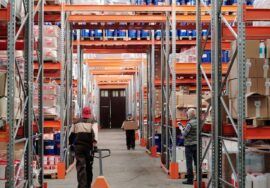
Some of the Biggest Future Trends in Manufacturing
From cars to computers, coffee machines to children’s toys, almost everything we use on an everyday basis is produced by manufacturers. It’s no wonder manufacturing is often described as a key building block of society.
Some of the Biggest Future Trends in Manufacturing has evolved over the centuries, from human-centered methods to machine-reliant assembly lines to the highly automated factories we’re beginning to see more of today. And the industry continues to evolve. Indeed, a number of trends are combining to transform manufacturing and, together, these trends can be referred to as “Industry 4.0.” Let’s explore the seven biggest trends that are contributing to Industry 4.0.
Trend 1: The Industrial Internet of Things (IIoT)
You’ve heard of the Internet of Things; well, now we have the Industrial Internet of Things (IIoT), where interconnected devices are used in manufacturing and industrial settings to collect data – data that can then be used to enhance the manufacturing process.
Sensors are a prime example of these interconnected IIoT devices. Data gathered from sensors on factory machines can help manufacturers understand how machines are performing, optimize the maintenance process, reduce machine downtime, and even predict when things will go wrong.
Trend 2: Predictive maintenance
In a manufacturing context, predictive maintenance refers to the use of sensor data and artificial intelligence (AI) to detect failure patterns in machinery and components. The idea is that by understanding when a machine or part is likely to fail, manufacturers can take preventative action and maintain their equipment more effectively.
And this doesn’t just apply to fancy new equipment. Siemens has used such sensors on older motors and transmissions – and by analyzing the data from these sensors, Siemens says it can interpret a machine’s condition, detect irregularities and fix machines before they fail. This shows how predictive maintenance processes can be applied even to legacy machinery.
Trend 3: Robots and Cobots
One of the key enablers of automation is the use of robots. But it’s worth noting that not all robots are there to replace human workers – many are there to enhance the work of humans. For example, we have robotic exoskeletons that help those on the production line lift heavier parts without compromising their safety. And we have collaborative, intelligent robots – or “cobots” – that are specifically designed to work alongside humans.
Robots and cobots can help manufacturers achieve greater efficiencies. This was the case for Nissan, who deployed Universal Robots’ robotic arms at its motor production facilities in Japan to help overcome problems around maintaining production times (largely due to labor shortages). Nissan also deployed cobots to help employees install engine intakes, among other tasks.
Trend 4: 3D printing
As 3D printing becomes more cost-effective, efficient, and scalable, manufacturers will increasingly be able to make products using 3D printing methods – which use fewer materials and create less waste than traditional manufacturing methods. I believe 3D printing will also drive a new era of personalization because individually personalized products can be made without worrying about economies of scale. Plus, 3D printing can help to drive innovation by allowing rapid prototyping.
Airbus has been using 3D printing technology for more than 15 years, making it something of a 3D printing pioneer in the manufacturing industry. The company extensively uses 3D printing for localized on-demand production of tooling, such as jigs and fixtures.





